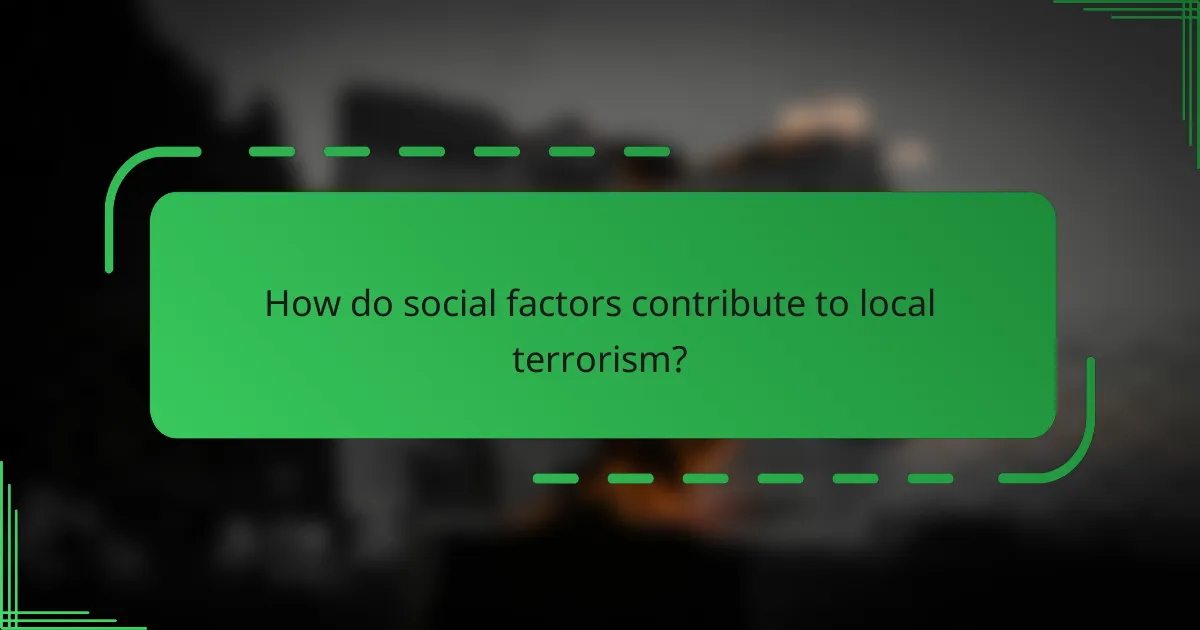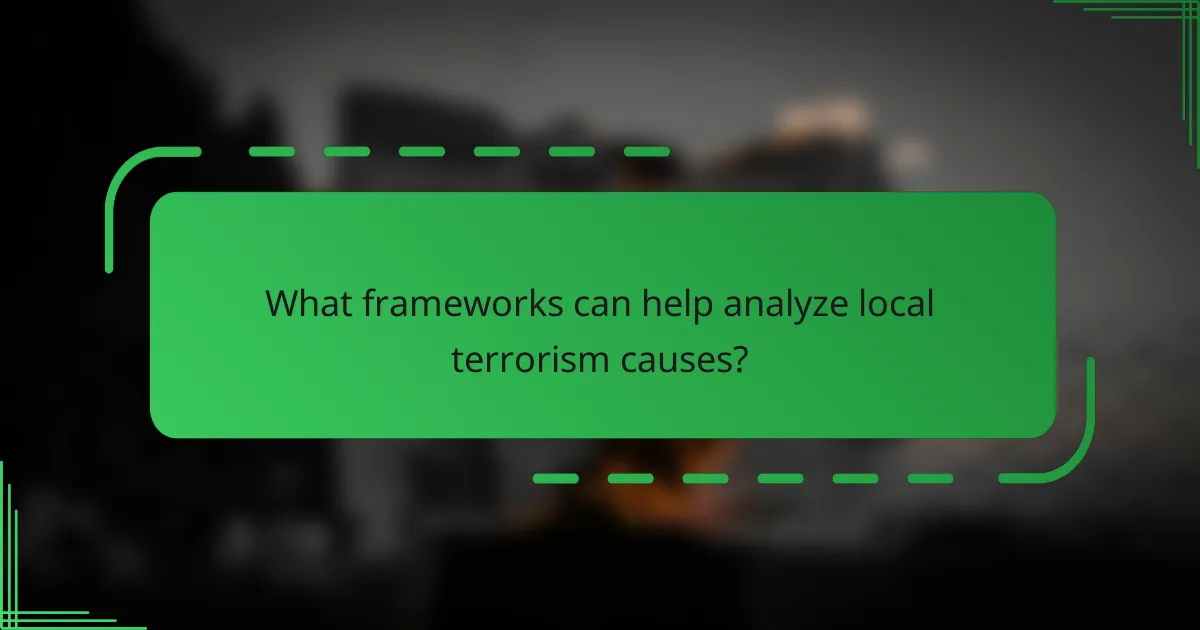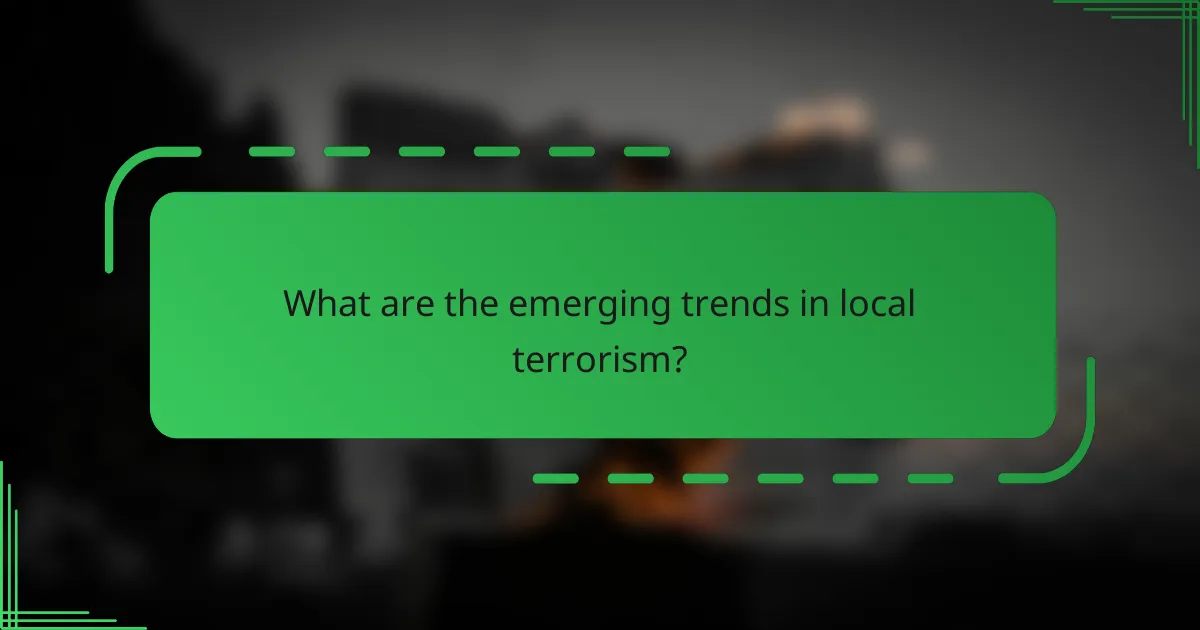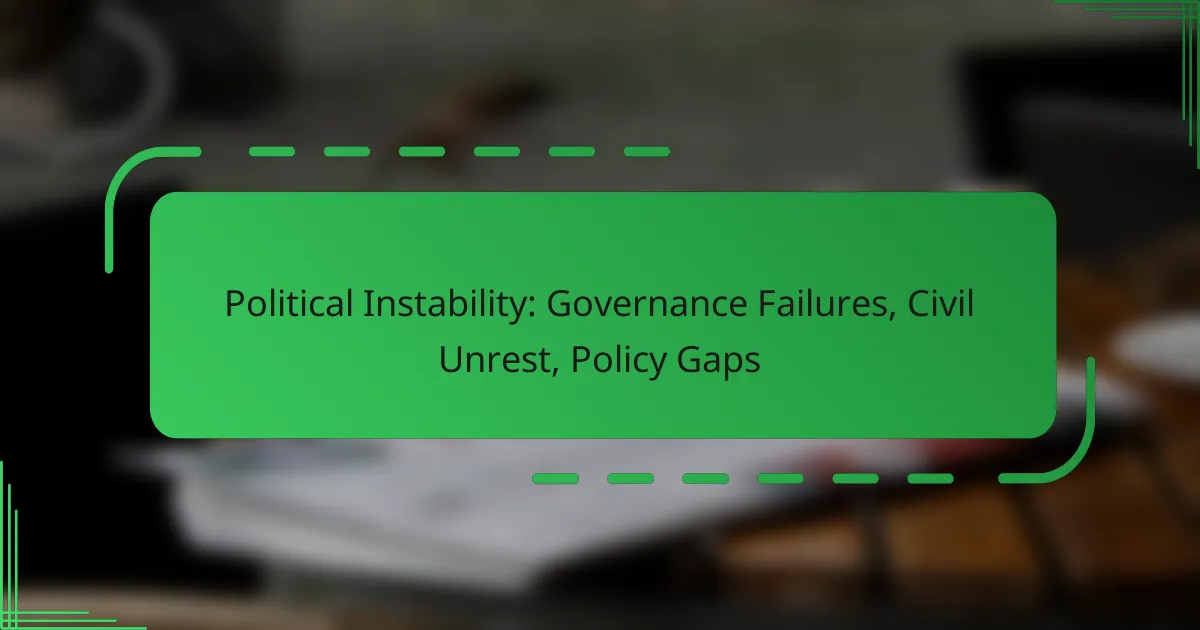Local terrorism is often fueled by a complex interplay of economic, social, political, and cultural factors. Economic hardships such as poverty and unemployment can foster desperation, while social marginalization can lead individuals to embrace extremist ideologies. Additionally, political repression and corruption may push marginalized groups towards violence as a form of protest or expression of discontent.

What are the economic causes of local terrorism?
Economic causes of local terrorism often stem from systemic issues that create environments of desperation and frustration. Factors such as poverty, unemployment, and income inequality can contribute significantly to the rise of extremist behaviors and groups.
Poverty and unemployment
Poverty and unemployment are critical economic factors that can lead to local terrorism. Individuals facing financial hardship may feel marginalized and hopeless, making them more susceptible to radical ideologies. In regions where the unemployment rate is notably high, such as certain areas in Eastern Europe, the lack of job opportunities can drive individuals toward extremist groups that promise financial support or a sense of belonging.
Communities with high poverty levels often experience a breakdown in social cohesion, which can further exacerbate feelings of disenfranchisement. This environment can create fertile ground for terrorist recruitment, as individuals seek alternative means to address their grievances.
Income inequality
Income inequality can fuel resentment and social unrest, contributing to local terrorism. When wealth is concentrated in the hands of a few, those in lower economic strata may feel excluded from societal benefits, leading to frustration and anger. This disparity can be particularly pronounced in urban areas where visible contrasts between affluent and impoverished neighborhoods exist.
Moreover, communities that perceive systemic injustice in wealth distribution may be more likely to support radical movements that promise change. Addressing income inequality through policy reforms and equitable economic opportunities is essential to mitigating these risks.
Lack of economic opportunities
A lack of economic opportunities can drive individuals toward extremist ideologies and actions. When young people, especially in developing regions, find few pathways to education or employment, they may turn to terrorism as a means of expressing their discontent. This is often seen in areas where educational systems are underfunded and job markets are stagnant.
To counteract this trend, it is crucial to invest in local economies by promoting entrepreneurship and vocational training. Creating accessible pathways for skill development can help reduce the allure of extremist groups by providing viable alternatives for young individuals seeking purpose and stability.

How do social factors contribute to local terrorism?
Social factors significantly contribute to local terrorism by creating environments where individuals feel marginalized and disconnected from their communities. These factors can lead to feelings of anger and frustration, making some individuals more susceptible to extremist ideologies.
Social alienation
Social alienation occurs when individuals feel isolated from their community or society at large. This disconnection can stem from various issues, such as economic hardship, discrimination, or lack of social support. When people feel they do not belong, they may seek out extremist groups that offer a sense of identity and purpose.
For example, in economically disadvantaged neighborhoods, individuals may experience high levels of unemployment and poverty, leading to feelings of hopelessness. This alienation can push some individuals toward radical ideologies that promise change or belonging.
Community fragmentation
Community fragmentation refers to the breakdown of social cohesion within a community, often due to factors like migration, economic disparity, or cultural differences. When communities become fragmented, trust and cooperation diminish, making it easier for extremist groups to exploit divisions.
In areas where different cultural or ethnic groups coexist without interaction, misunderstandings and prejudices can flourish. This lack of unity can create an environment ripe for radicalization, as individuals may turn to extremist groups that claim to represent their interests or grievances.
Radicalization through social networks
Radicalization through social networks occurs when individuals are influenced by peers or online communities that promote extremist views. These networks can provide validation for feelings of anger and frustration, reinforcing the belief that violence is a legitimate response to perceived injustices.
Social media platforms often facilitate the spread of extremist content, allowing individuals to connect with like-minded people. This online interaction can lead to a sense of belonging, making it easier for individuals to adopt radical beliefs and, in some cases, engage in terrorist activities.

What political conditions lead to local terrorism?
Political conditions that contribute to local terrorism often include government repression, corruption, and political exclusion. These factors can create an environment where individuals feel marginalized and resort to violence as a means of expressing dissent or achieving their goals.
Government repression
Government repression occurs when authorities use force or coercion to suppress dissent and limit freedoms. This can lead to widespread resentment among the populace, particularly if the repression is perceived as unjust or excessive.
Examples of government repression include the unlawful detention of activists, censorship of media, and violent crackdowns on protests. Such actions can push individuals towards extremist ideologies as they seek alternative means to voice their grievances.
Corruption and lack of trust
Corruption within political systems erodes public trust in government institutions. When citizens perceive their leaders as self-serving and dishonest, they may feel that legitimate avenues for change are futile.
This lack of trust can foster a sense of hopelessness, making radical solutions more appealing. In regions where corruption is rampant, such as in parts of Eastern Europe, individuals may turn to terrorism as a form of protest against perceived injustices.
Political exclusion
Political exclusion refers to the systematic denial of certain groups from participating in political processes. This can happen based on ethnicity, religion, or socioeconomic status, leading to feelings of disenfranchisement.
When groups are marginalized, they may resort to violence to demand recognition and rights. For instance, in various countries, ethnic minorities who feel excluded from political representation may engage in terrorist activities to draw attention to their plight and seek change.

How do cultural influences affect local terrorism?
Cultural influences play a significant role in shaping the motivations and actions behind local terrorism. Factors such as identity crises, religious extremism, and cultural grievances can drive individuals or groups to resort to violence as a means of expressing their frustrations or asserting their beliefs.
Identity crises
Identity crises often arise when individuals feel disconnected from their cultural or national identity. This disconnection can lead to feelings of alienation and resentment, making some individuals more susceptible to extremist ideologies that promise a sense of belonging or purpose.
For example, young people in marginalized communities may struggle with their identity in a rapidly changing society, leading them to seek out groups that reinforce a strong, albeit radical, sense of identity. These groups often exploit vulnerabilities to recruit members who feel lost or disenfranchised.
Religious extremism
Religious extremism is a potent cultural influence that can fuel local terrorism. When individuals interpret religious texts in a way that justifies violence against others, it can lead to radicalization. This often occurs in environments where individuals feel their religious identity is under threat.
Communities may experience increased tensions when religious beliefs clash with secular values or when there are perceived injustices against their faith. Such dynamics can create fertile ground for extremist groups to thrive, as they offer a narrative that frames violence as a righteous response to oppression.
Cultural grievances
Cultural grievances arise when groups feel that their traditions, values, or rights are being undermined or disrespected. This can lead to a strong sense of injustice and a desire to retaliate against perceived oppressors, which can manifest in violent actions.
For instance, indigenous populations or ethnic minorities may resort to terrorism as a means of fighting against cultural assimilation or discrimination. Addressing these grievances through dialogue and policy changes can be crucial in preventing the escalation of violence.

What frameworks can help analyze local terrorism causes?
Several analytical frameworks can effectively examine the causes of local terrorism, focusing on socioeconomic, political, and cultural factors. These frameworks help identify underlying issues that contribute to radicalization and violent extremism.
Socioeconomic models
Socioeconomic models analyze how economic conditions, social structures, and individual circumstances contribute to terrorism. Factors such as poverty, unemployment, and lack of education can create environments where individuals are more susceptible to radical ideologies.
For instance, regions with high unemployment rates may see a rise in local terrorism as disillusioned youth seek purpose and identity through extremist groups. Understanding these socioeconomic dynamics can inform targeted interventions, such as job creation programs and educational initiatives.
Political theory frameworks
Political theory frameworks explore how governance, political repression, and civil liberties impact the likelihood of terrorism. Authoritarian regimes or governments that fail to address grievances may provoke violent responses from marginalized groups.
For example, when citizens feel their voices are ignored, they may resort to terrorism as a means of political expression. Analyzing political contexts helps identify potential flashpoints and may guide policymakers in fostering inclusive governance to mitigate risks.

What are the emerging trends in local terrorism?
Emerging trends in local terrorism highlight the evolving nature of threats, influenced by various economic, social, political, and cultural factors. Understanding these trends is crucial for developing effective prevention and response strategies.
Impact of technology on radicalization
Technology plays a significant role in the radicalization process, providing platforms for extremist ideologies to spread rapidly. Social media, encrypted messaging apps, and online forums facilitate connections among like-minded individuals, often leading to the formation of local terrorist cells.
Moreover, technology enables the dissemination of propaganda, making it easier for groups to recruit and radicalize individuals. For instance, videos and articles that glorify violence can reach a global audience, impacting local communities and increasing the risk of homegrown terrorism.
Globalization and local responses
Globalization has interconnected economies and cultures, which can both mitigate and exacerbate local terrorism. While it fosters economic opportunities and cultural exchange, it can also lead to feelings of disenfranchisement among certain groups, potentially fueling extremist sentiments.
Local responses to these dynamics are critical. Communities may implement programs that promote inclusivity and understanding, counteracting the divisive narratives that can arise from globalization. For example, community engagement initiatives that focus on cultural awareness can help bridge gaps and reduce tensions.
Shifts in community resilience strategies
Communities are increasingly adopting resilience strategies to combat local terrorism, focusing on prevention and recovery. These strategies often involve collaboration among law enforcement, local governments, and community organizations to identify and address underlying issues that contribute to radicalization.
Effective resilience strategies may include educational programs that promote critical thinking and media literacy, enabling individuals to recognize and reject extremist content. Additionally, fostering strong social networks can provide support systems that deter individuals from engaging in terrorist activities.



